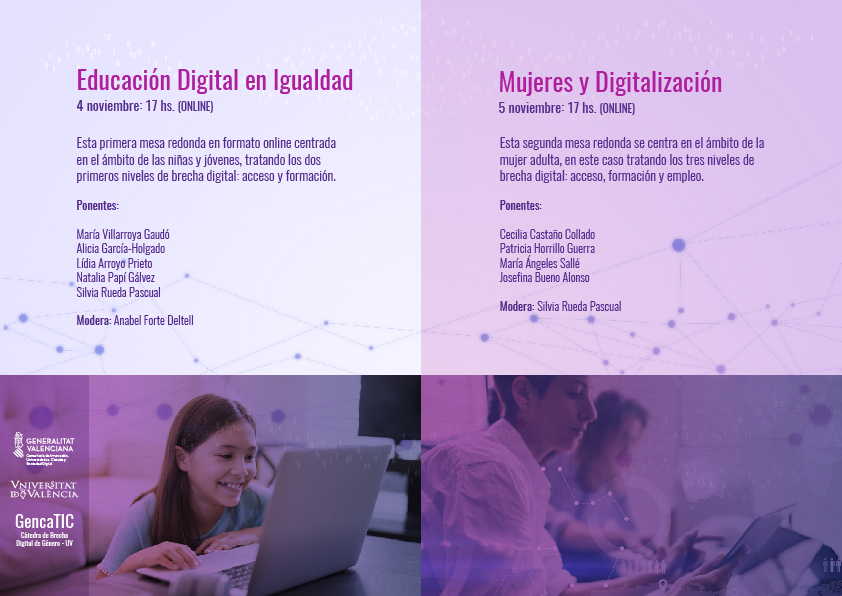
The Chair of Digital Gender Gap, which was launched this October as a result of an agreement between the University of Valencia and the Valencian Government, has organised on November Wednesday4 and Thursday 5 its first “Days for the equality of digital genre”. These consist of two round tables in which the different levels of the digital gender gap will be discussed at all stages of life, from girls to adult women. Access and participation in the sessions is free and you must first register at the link https://ir.uv.es/aYhJk9w.
Retransmission: ir.uv.es/cbdg/jornadas2020 .
The objective of these sessions is to generate debate on good practices and measures to close the digital divide at all levels: access, training and employment.
The first round table will be on Wednesday, November 4 with the title “Digital education in equality”. Silvia Rueda, director of the Department of Informatics at the University of Valencia, will participate, as well as director of the Chair of Digital Gender Gap and coordinator of the Girls4STEM project. Also María Villarroya, doctor in Electronic Engineering, professor at the University of Zaragoza and creator of the project “An engineer in each school”; and Lidia Arroyo, sociologist and researcher of the Gender and ICT group at the Open University of Catalonia. The table is completed by Alicia García-Holgado, from the GRIAL Research Group of the University of Salamanca, where she co-leads the line “Social responsibility and inclusion”; and Natalia Papí, director of the Chair of Generational Digital Gap at the University of Alicante and the Valencian Government. The table is moderated by Anabel Forte, from Girls4STEM. This first round table will focus on the field of girls and young people, and will deal with the first two levels of the digital divide: access and training.
On Thursday, the round table “Women and digitisation” will pay attention to the adult woman and will address the three levels of the digital gap: access, training and occupation. Moderated by Silvia Rueda, Cecilia Castaño, professor of Applied Economics at the Complutense University of Madrid and professor of Gender and Occupation in the Master’s Degree on Gender Studies: Public Policies and Social Intervention; and Patricia Horrillo, journalist and activist behind multiple collaborative projects with the aim of generating active communities and breaking with the traditional one-way broadcasting model. The table will be completed by MaríaÁngeles Sallé, PhD in Social Sciences from the University of Valencia and specialist in promoting, planning, comprehensive management and evaluation of policies and initiatives for development and socioeconomic and technological change in Spain and Latin America; and Josefina Bueno, PhD in Philosophy and Letters from the University of Murcia and an expert in gender studies and African literatures written by women.
About the Chair of Digital Gender Gap
The purpose of the Chair of Digital Gender Gap, hosted at the University of Valencia, is to address the existing digital gap between women and men. The Chair was born from a broader project linked to the Digital Gap Observatory, dependent on the Department of Innovation, Universities, Science and Digital Society.
The Observatory coordinates the joint work of different universities to achieve a common goal: to reduce the digital gap. That is why a network of five chairs linked to this observatory has been created, one for each of the Valencian public universities. To guarantee an inclusive digital society based on equal opportunities, it must also be ensured that ICTs are available to all citizens. It is essential to analyse the digital divide from all aspects and study the different socioeconomic causes and possible solutions.
In this sense, the Chair of the Digital Gender Gap will develop a system of indicators that will make it possible to identify the population and geographic areas most affected by the digital gap in order to provide the Observatory with qualitative and quantitative information in this regard. In addition, the chair will prepare publications for the dissemination of knowledge on the subject of the digital divide and will promote and participate in conferences and works on this matter in collaboration with public administrations or other organisations. These conferences on digital gender are the first action.
Images:








